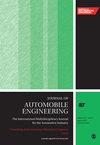在冬季行驶条件下,在加拿大商业运营的公共公路上进行卡车排车合作试验
IF 1.5
4区 工程技术
Q3 ENGINEERING, MECHANICAL
Proceedings of the Institution of Mechanical Engineers Part D-Journal of Automobile Engineering
Pub Date : 2024-04-18
DOI:10.1177/09544070241245477
引用次数: 0
摘要
卡车协同编队是指卡车组成的车队在相互沟通和协调的情况下共同行驶,它是一种以技术为驱动的方法,可提高能源转换效率、降低温室气体排放并加强道路安全。尽管已有大量研究对这些潜力进行了探索,但对商业运营期间,尤其是冬季驾驶条件下的公路合作卡车编队进行的实证调查却很少。本文介绍了一项实验研究的结果,该研究使用两辆 SAE 2 级 8 号卡车,在加拿大冬季的一条公共公路上首次实施了以商业为重点的卡车排车。路面试验在卡尔加里和埃德蒙顿之间的伊丽莎白女王二世高速公路上进行,环境温度从零下 27 摄氏度到 12 摄氏度不等,卡车重量从 16 吨到 39 吨不等。九名训练有素、经验丰富的驾驶员进行了 41 次无事故(排驾和基线)测试,行程达 22,855 公里。实验结果证实,在加拿大冬季包括各种路面条件下,在公共道路上以 3-5 秒的时间间隔运行商用卡车排车是可行的。实验结果还显示,排车参与率高达 88.9%,在 25 次排车中平均参与率为 61.6%。此外,在排车过程中,跟车卡车在平坦路段上节省了 1.6% 的燃油,但在丘陵地形上,其货运特定燃油消耗却高于跟车卡车。测试结果表明,轻型卡车的氮氧化物(NOx)具体排放量更高。此外,卡车协同编队系统的频繁启动和解除对卡车的动力总成系统产生了不利影响,导致油耗和发动机排出的氮氧化物排放量增加。这项研究提供了真实世界的数据,以确定将卡车协同排布技术应用于公共道路商业运营的局限性和需要改进的地方。本文章由计算机程序翻译,如有差异,请以英文原文为准。
Cooperative truck platooning trial on Canadian public highway under commercial operation in winter driving conditions
Cooperative truck platooning, a convoy of trucks driving together while communicating and coordinating with each other, represents a technology-driven approach to improve energy conversion efficiency, lower greenhouse gas emissions, and enhance road safety. Despite numerous studies have explored these potentials, there is a scarcity of empirical investigations into on-road cooperative truck platooning during commercial operations, particularly in winter driving conditions. This paper presents the findings of an experimental study on the first commercially focused truck platooning implementation on a Canadian public highway in the winter season, using two SAE level 2 class 8 trucks. The on-road trials took place on the Queen Elizabeth II Highway, between Calgary and Edmonton, with ambient temperatures ranging from −27°C to 12°C, and truck weights spanning 16–39 tons. Nine well-trained and experienced drivers conducted 41 incident-free (platooning and baseline) test trips, covering a distance of 22,855 km. The experimental results confirmed the feasibility of operating commercial truck platooning with 3–5 s time gaps on public roads during the Canadian winter season including various road surface conditions. The results also show that the platooning engagement ratio reached up to 88.9%, with an average of 61.6% across 25 platooning trips. Furthermore, the follower truck achieved a 1.6% fuel savings on flat road sections during platooning, but its freight transportation specific fuel consumption was higher than that of the lead truck on hilly terrain. Test results indicate the lighter truck exhibited higher specific nitrogen oxides (NOx) emissions. Moreover, the frequent engagement and disengagement of the cooperative truck platooning system had adverse effects on the powertrain system of the truck, leading to increased fuel consumption and engine-out NOx emissions. This study provides real-world data to identify limitations and needed areas for improvement in adapting cooperative truck platooning technology to commercial operations on public roads.
求助全文
通过发布文献求助,成功后即可免费获取论文全文。
去求助
来源期刊

CiteScore
4.40
自引率
17.60%
发文量
263
审稿时长
3.5 months
期刊介绍:
The Journal of Automobile Engineering is an established, high quality multi-disciplinary journal which publishes the very best peer-reviewed science and engineering in the field.
 求助内容:
求助内容: 应助结果提醒方式:
应助结果提醒方式:


